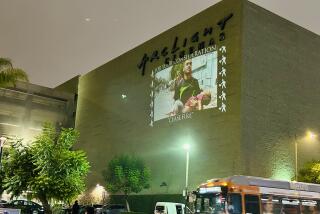A Sculpture to Put Some Light on Dark Days
- Share via
The blacklist is returning to Los Angeles. But instead of another round of congressional witch hunts and redbaiting that abused Hollywood filmmakers and many other American citizens for their political beliefs--or alleged beliefs--in the late 1940s and early ‘50s, plans are underway for an artwork designed to inform the public about that infamous period of history and help prevent a rerun.
“The First Amendment/Blacklist Project,” to be announced at a press conference today at the Academy of Motion Picture Arts and Sciences Library, is a large multimedia sculpture by New York-based artist Jenny Holzer. Project organizers are launching the public phase of a $250,000 fund-raising campaign to construct the artwork, install it on the lawn near the entrance of Fisher Art Gallery at USC and provide a small endowment for maintenance.
With more than $30,000 already in hand, a groundbreaking ceremony is planned for Oct. 20, the 50th anniversary of the date when the House Committee on Un-American Activities subpoenaed 10 filmmakers to testify about their “subversive” views. Now known as the Hollywood Ten, they refused to testify and were prevented from working at film studios and broadcast networks.
The project is finally coming to fruition after nearly 10 years of discussion and planning. It began in USC’s School of Cinema-Television, said Margaret Mehring, who developed and directed the school’s Filmic Writing Program. The late Max Lamb was teaching a class about the history of screenwriting in 1988 when he showed a documentary film about the blacklist era to incredulous students who knew little if anything about the subject and invited filmmakers to talk about their experiences during that period.
“One student, Drew Weinbrenner, came into my office after the class and said we should create a monument about the blacklist,” Mehring said. His suggestion led to discussions with Selma Holo, director of USC’s gallery and museum studies program. Eventually they formed a working committee predominantly composed of screenwriters, film historians, art museum directors and curators.
Now living in Orlando, Fla., where he is a technical writer for a computer software company, Weinbrenner claims to be only one of many students who spearheaded the project. “I can’t take the credit. I’m just a guy with a big mouth,” he said. But he does have definite ideas about the artwork. “It’s not a memorial to dead screenwriters. They won the war. We want to carry on their legacy and be sure that period does not return.”
*
From the beginning, the committee decided the monument should focus on issues raised by the blacklist rather than specific victims. After compiling a list of artists who might create the work, they invited candidates to submit proposals. Holzer, who is internationally known for public works that address political issues and generally make use of text, was their unanimous choice.
She was a natural, Mehring said. “I thought the piece had to be interactive. It had to be something that called people to it, not just something they would walk by and say, ‘How nice.’ And that’s the way Jenny works.”
Reached by telephone in Switzerland, Holzer said she was immediately attracted to the project because it involves the sort of “fraught subject” she likes to grapple with. “But that’s all the more reason to tremble at the brink. It’s hard to do justice to subjects like this,” she said.
In developing her sculptural work, she visited the campus and talked with students, committee members and blacklisted writers. The project she conceived has three components. The first is a circular arrangement of granite benches, inscribed with text from the Bill of Rights and statements on American ideals of freedom.
While sitting on the benches or standing nearby, visitors will hear recorded excerpts from the 1947 congressional interrogation of the Hollywood Ten and recent interviews with blacklisted screenwriters and their survivors. Four or five hours of tape will be used to avoid repetition for those who stay a long time or return to the piece, Holzer said.
The third component, only visible at night, is a searchlight that alludes both to Hollywood premieres and wartime, she said.
While her planned work at USC addresses a specific historic period, Holzer also sees it in terms of contemporary events that have subjected artists to politicians’ scrutiny and censorship. “Using the arts as a political football is a stepchild of this,” she said of the blacklist.
For those who were personally affected by blacklisting 50 years ago, however, the artwork brings back vivid memories. “I lived through that period at USC,” Mehring said. “The educational community was deeply threatened. If students didn’t like the grades they got, all they had to do was put a note in a mailbox saying they suspected you [of being a Communist]. And that happened. It was terrifying.”
More to Read
The biggest entertainment stories
Get our big stories about Hollywood, film, television, music, arts, culture and more right in your inbox as soon as they publish.
You may occasionally receive promotional content from the Los Angeles Times.










